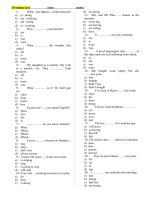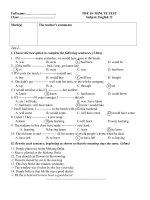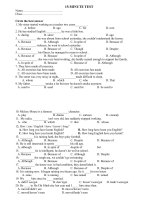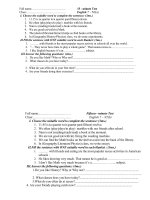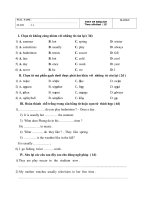15 minute dance workout
Bạn đang xem bản rút gọn của tài liệu. Xem và tải ngay bản đầy đủ của tài liệu tại đây (24.39 MB, 132 trang )
15 minute
dance
workout
Caron Bosler
»15minute
ance
Caron Bosler
--..............UIndan, .... 'IbIc, ~
fIUti\. n
DellI
..... M_ArnI~
7 llra-Ral
...,..,...,
77
~
........ anty I..uIiIf<
. . . . M EcIIat &:.l 00wr'*Ig
......... EcItDr o.n HalidlillOl,
......... Art EctIor CI'ItIttle KeIfy
Art: DhaIar Peter lui
PlmIIt*Ig ChatDr fMoy<:wG JBrrwn
. . . PhotDgI~ F\sth JenIdn8cn
DTP o.IQnIr Scria CI'wrbon ..
PnxFuctIon ConttOIIIr Nat ~
ProcIud:Ion Edttor lLa! r..hIttI
"".... - .......
""'--
O\ID prod.x::ed for 00rt'1g ~
C7IrDrIMI ProcIuctIonI
btt
~can
_ _ ow.-
.......
"""- ......
c.n.. EIEredIot Spanaa. Joe ~
PraduatkIn ... I. ,I Inne MIIIIII
!
....IN.....,
IIbIc a.d Hobeon I Scott SNIIdII FeIk
~
~
\IIcIOOa a.n.
e...
c.tn Boller
AIoonItV
Ben..lc:ta
fhI: AmIrIcen EdIIon. 2009
DK...--.n
NlIWlIIcI
hlk*-f StIl8I btt
tJr sIIIcs promotla IS, prtI'T'IUns,
375 I'tIdIon Street
New 'lb'k. New'tbrk 10014
tnd-raIIIIrcI, or edua!IIonaI use.
Fa details, contact: OK Publiahhg
Special Marteta, 375 Huclaon Sbget,
N9N 'Itlrk, New 'Itlri< 10014 or
SpaoIalSal890dk.oom.
091011 1088786 .. 821
""""'-JIn.wy'"
_..-
~ 0 2008 ~
'lid ~ 0 200II
.
MhFMIiIIJ linIacI
....._
c.an BoIMr
'It1IhauI: ~ . . ~ LnIIr~...-i . . . . m
~"'''''''''*", ..,.-~lilt. WiIICU . . p1ar WitiIn paii' 5
0CIPJ1IVt CIIMW' 1IICI . . 1IbcIw pWIIIw
boIIk
CI'''.
~ants h I!tna88 actIvltie8 muat assume the
I'8IpOIIlIbIIty for their own actlone and saI'e1y. If you haY8
.,.,.. health problEms or medloal oondIbns, ClClI'1SIJt Ywfth
)'011 dootor baIoro ~ tI'rI r:l1hII 8ClMi1os set
aut h It* back. n. ..." .......... h It* book
---_
_-_
- ...-
...
...........................
...,.
••
I."""
_1IIII_"on
..
__
....
eII_
...
_~"P""'~·~"""'fI
II'IIICIcba:I ~ allllrlMlll)1llllm. fl •• •• ...a. h II'J fDrIn..
.
..hwamlng
NiIiIt.:i h Chiil7IrM1 br' Darq 10. . . . ,...,
ACIIIIIcig NCICiid b . . bade ,. . . . . . . . . ....,
11111. _ _
contents
AuthorFotaword
_Workout
&
1&
How to Use 1hIs Book &
_
Workout Sumll18lY
Exerdse and Posture
_
Workout FAQa
Dance Into Fitness
10
12
The Structure of a Workout
for' Beginners
16
BalletWorkout
14
34
40
42
Ballet Workout Summary
Ballet Workout FAa.
58
tl4
Jazz Workout &&
Jazz Workout Sumll18lY 82
Jazz Workout FAa.
B8
Straet WOfI
_01
_ _ utSumll18lY loti
Street
FAQa 112
Dance~
114
Glossary of Der<:e Terms 116
Dance Styles
118
Finding a Class and Teacher
Useful Raaourcaa
124
Index 126
~
128
122
6
>>
author foreword
Like most girls in Texas, I started dance class at the age of 12,
to appease a nagging mother who was secretly praying that
I would learn to walk straight with a little more grace than a
bulldozer. To her surprise, I loved it. The annual dance recital is
the highlight of most dance schools, and before I left for North
Carolina School of the Arts at 15 years old to study dance,
I went out with a bang. On stage, first piece, collision with a
sound box, head injury, eight stitches. The ambulance crew
came down the center aisle...
While learning to avoid sound boxes in high school, I started
working in gyms to help support myself while dancing. After that,
I never stopped studying. I continued my journey northward and
studied dance in college at The State University of New York at
Purchase. In 1992, I was a freshman, and traded free certification
in the Pilates Method for free labor. A year and a half later, I knew
I’d hit it big time when I was teaching Pilates for $12 an hour.
What I didn’t know, and am happy to say, was that my college
job would become my life. Teaching health and fitness proved to
be a wonderful way to support myself while on scholarship with
The Merce Cunningham Dance Company in New York and
throughout my Masters in Dance at The Laban Centre, London.
Now I have moved to London, and although I quit dancing
professionally at 28 years old, dance is still at the heart of
everything I teach and do. The principles I learned when studying
dance—posture, length, elongation, moving from your core, poise,
grace, fluidity, and style—have transcended the classroom and
become part of my everyday life. They can be part of yours, too.
7
I incorporate all those principles in the private fitness lessons
I have given over the last 10 years. This time has been a truly
unique and wonderful experience. The benefit of teaching people
in their own homes is that you can really get to know them and
get to the root of what will motivate them. Part of that motivation
lies in ensuring that they are having fun during the lesson. If the
client is not enjoying exercising, he or she won’t do it again.
The downside to private training is that you are limited by the
hours in a day and the number of people you can meet in that
time. Working on this project is my way of trying to spread some
of the fun—and my passion for dance—just a little bit further.
The most important thing I would like anyone to get out of these
workouts is the sheer joy of dancing. Sweating, having a fit body,
plenty of stamina, and flexibility come in just a touch below...
The best way to enjoy these dance workouts is to allow
yourself the freedom to play. Doing this without self-judgment
is all part of the joy of learning something new. So start by
committing to make time for yourself to learn this new skill.
You will feel more positive and uplifted, knowing you are doing
something, every day, that benefits your heart, lungs, body, and
mind. This is my hope—for anyone who wants to get and stay
in shape.
8
>> how
to use this book
k
Each of the four 15-minute dance programs in this book offers a
complete, aerobically structured workout (see p14). Take time to study
the exercises in detail and familiarize yourself with each step. Use the
gatefold summary as a quick reminder.
Each of the dance programs can be done at a
beginner, intermediate, or advanced pace. You do
not have to do them in any particular order—just
start with the one you like the look of best.
The accompanying DVD demonstrates all four
programs. Before starting each dance, read
through the workout in the book so that you are
familiar with what lies ahead, and what aspects to
focus on. For example, the ballet workout highlights
soft, beautiful arms, while the salsa workout
centers on the movement of the hips.
The DVD offers a mirror image for you to follow
along with, just as you would mirror the teacher in a
dance class. The voice-over helps to reinforce the
DVD, by giving the name of each movement along
with telling you which leg you should be using. As
you watch the DVD, page references to the book
flash up on the screen. Refer to these for more
detailed instruction. The insets in the book will help
remind you of the step you have recently done and
to which you are about to add a variation. The
annotations give you tips on proper positioning or
what to watch out for in each movement.
Finally, throughout the book, one repetition, or
rep, refers to repeating a move to both right and left.
The gatefolds
These show each dance workout from beginning to
end. Once you’ve watched the DVD and examined
each move, use the gatefolds as a quick reference.
The more familiar you are with each workout, the
better you will perform them.
Safety issues
Be sure to get clearance from your healthcare
provider prior to beginning any exercise program.
The advice and exercises here are not intended to
be a substitute for individual medical help. Your
medical specialist may recommend preparatory
exercises especially tailored to your needs.
jazz at a glance
1
2
3
S�Warm-up Plié shoulder S Warm-up Torso twist,
circles, page 68
page 68
17
S Warm-up Hip side to side,
page 69
18
4
5
S Warm-up Head looks,
page 69
S Aerobic Ball change 1,
page 70
6
S Aerobic
page 70
19 15 20
1
2
16
S�Aerobic Box step 2, page 76
S�Aerobic Grapevine 2, page 76
S�Aerobic Step touch 2, page 77
S Aerobic Ball change 3, page 77
The gatefold gives you a comprehensive demonstration
of the entire workout—an easy reference to make your
practice quick and simple.
S
Ball change 1,
100
>> aerobic grapevine 2/forward & back 2
17
>> aerobic heel dig 2/box step 3
18
19
9
101
20
annotations provide
extra cues, tips, and
insights
>>
street
street
>>
Step-by-step pages The inset photograph at the upper left
gives you the previous variation of the movement, unless
stated otherwise. The large photograph shows you the next
level of the movement.
8
7
S�Aerobic Cross touch 1,
page 71
14
21
17
S�Aerobic Cross
touch 1, page 71
22
9
10
11
12
S Aerobic Box step 1,
page 72
S�Aerobic Box step 1,
page 72
S�Aerobic Grapevine 1,
page 73
S Aerobic Grapevine 1,
page 73
23
24
18
S�Aerobic Cross touch 3, page 78
S Aerobic Grapevine 3, page 79
S Aerobic Step touch 3, page 79
S Aerobic Step touch 1, page 74
25
S Tone & stretch
Abs, page 80
S�Aerobic Box step 3, page 78
13
14
S Aerobic Step touch 1,
page 74
15
S�Aerobic Ball change 2,
page 75
16
S�Aerobic Cross touch 2,
page 75
27
26
S�Tone & stretch
Quads, page 80
the gatefold shows all the
main steps of the sequence
S Tone & stretch
Spine, page 81
28
S Tone & stretch Hamstrings, page 81
10
>> exercise
and posture
Exercise benefits your mind as well as your body. It makes you feel more
energized and better prepared for whatever life throws at you. And, if
you cultivate good postural habits, you will not only see the benefits in
your everyday movements, but you’ll start to look and feel better too.
Aerobic, or cardiovascular, exercise simply means
any form of exercise that keeps the heart rate high
over a sustained period of time. Aerobic literally
means “with oxygen.” By increasing the heart rate
and strengthening the heart (see p14) and lungs,
the body is able to use oxygen more efficiently.
The system known as “aerobic exercise” was first
developed in 1968 by Dr. Kenneth H. Cooper
in San Antonio, Texas. It originally consisted of
exercises such as cycling, running, and swimming,
but from those simple beginnings arose the
aerobics exercise phenomenon we know today.
The “Talk Test”
Always work within safe limits when exercising.
The simplest way of checking is to use the “Talk
Test.” Quite simply, if you can talk comfortably while
you are exercising, your heart rate is functioning
within a safe range. If you are feeling breathless
or uncomfortable, you should stop.
Correct posture
Correct posture and alignment are important not
only when exercising, but in your daily life as well.
Walking, standing, carrying heavy objects, or
holding briefcases all take their toll on the spine.
With just a little effort, you can have perfect posture
and a healthy spine throughout your life.
Continuous aerobic exercise enhances the production
of serotonin, a neurotransmitter with effects on the brain
that include mood elevation.
Practice standing correctly every day, and you will
see the benefits in no time. A good time to practice
is in the morning while you are brushing your teeth
in front of the mirror. Stand with your feet hip-width
apart and parallel to each other. Make sure your
weight is evenly distributed between your feet. Rock
slightly forward and back on your toes and ankles.
You want to settle your weight slightly in front of
your ankles. Your knees should be soft and never
locked. Your hip bones should be even—check that
they are not tilted to one side or the other—and
your tailbone should be lengthening toward the
ground. Lift your abdominal muscles and lengthen
your head up toward the ceiling. Think of your
shoulders as open and relaxed. Envision a vertical
line straight from the top of your ear and through
the middle of your shoulder, hip, knee, and ankle.
Get used to this feeling, and, as you carry on
with your everyday life, try to think about how you
are standing from time to time. Keep that awareness
when sitting, too, making sure that your head and
abs are lifting, and that your shoulders are open.
Correct posture and alignment are essential in
preventing lower-back pain. By pulling in the abdominal
muscles, pressure is taken off the lower back.
>> benefits of aerobic exercise
• Reduces the risk of heart disease,
diabetes, and other diseases
• Helps weight loss
• Improves metabolism
• Strengthens the heart
• Lowers the resting heart rate, which means
your heart does not have to work as hard to
pump blood around your body
• Increases the body’s ability to use oxygen
more efficiently and so burn fat faster
• Decreases stress levels
11
12
>> dance
into fitness
When you practice dance, you will notice an improvement in poise,
grace, alignment, and coordination, as well as a better understanding
of rhythm, an improvement in your memory, increased self-esteem, and
a greater appreciation of music. There are many other benefits, too.
In addition to giving you a great workout and
improving your balance, dance will give you
elongated, well-defined, well-toned muscles and a
strong, sculpted body. It stretches and strengthens
the muscles, but works the body very differently
than lifting heavy weights in the gym, which builds
bulk and shortens the muscles. Dance is also great
for increasing the flexibility of the spine, hips, and
other joints. And if that weren’t enough, it also
gives you the greater self-awareness you need
to improve your posture and alignment.
Most postural problems occur through lack
of awareness and laziness. By introducing dance
into your life, you will become more aware of the
position of your head, neck, and shoulders in
relation to the rest of your body (see pp10–11),
and that is the first step on the road to correction.
Dance as an aerobic activity
Unfortunately, because of the way a dance
class is usually structured, dance is not usually
considered to be an aerobic activity. Normally, a
ballet teacher, for example, will stop the class each
time he or she wants to show a sequence at the
barre or when teaching floor work. True aerobic
activity must be continuous, so this type of dance
class will not offer you an aerobic workout.
My four workouts give you the best of both
worlds: A combination of aerobics and dance.
And, they can be enjoyed in optimal time—just
15 minutes! What is more, each one can be tailored
to beginner, intermediate, or advanced levels. You
don’t have to do them in a specific order: Just start
with your favorite dance style.
Why these dance styles?
In my choice of dance styles for this project, I have
tried to reflect something of the vast range of
popular dance genres. I have chosen from both
mainstream popular dance culture and from dance
as a classical art form. As you learn a few moves
from classical ballet, I hope you will gain a greater
understanding and appreciation of that style of
dance. The tone and movements of the jazz
workout are reminiscent of Bob Fosse and the
Broadway musical. Salsa, with its gentle rolling of
the hips, has a sultry Latin-American mood, while
the street workout has an earthy, grounded feel.
One dance genre might appeal to you more than
another, but trying them all can be lots of fun.
The movements are really easy to pick up.
Always learn the feet first, then add the arms, and,
when you are feeling confident, add the shoulders
and hips. Don’t forget to have fun and to add your
own personal style to the steps.
13
14
>> the
structure of a workout
Usually, when you go to an aerobics class, you will notice that the
exercise you do has three distinct sections. First there is the warm-up,
then the aerobic section, and finally, a toning and stretching section.
These dance workouts are structured in exactly the same way. '.
The warm·up does exactly what you YJOuld
imagine. It warms up the body and mobilizes the
Joints and muscles In preparation for the exercise
that follows. If you walked Into class without
warming up and went straight nto jumping, you
coukj serklusly n)xe YOU","'. By performing some
~t stretches as a warm-up, you open the joilts,
increase '!her range of motion, !rid EWe gettilg the
body reOOy for""", actlv9~.
The _Ie lI8CIIon
The aerobic section Is the longest section 01 any
aerobics class. his deoV>ed to _ _ you: heart.
The heart ts 8 mu9de 8'ld. j.JSt like other muscles,
respor Ids wei to exerd:se. You" hem1 rate is the
runbel' r:A times your heart beats, or contracts, per
mute. 000g eerobIc exercise gently I'1cree8ee Ite
runbel'" of beats per mute, r8si1g the heart rate,
a'1d strengthening the heart. The eerobIc CLIVO ~
a term U68d to describe how, a.mg aerobic
exerciBe, yQlJ( heart rate Is gently increased,
sustained, and then brought back down to your
~heertrate.
In this book and DVD. eech dance wor1«>ut
CONists 01 five basic movement. (Levej 1). You
start by pelfOlTlil1g these, then they are dErw eloped
... 00IcaIy n Y81ioos _
sucIlas by Ite add_
01 en ..." """"""'" (J( by • deeper bend of Ite
knees, (J( by traYelng Ite ~ throogh space
(lJMII2). At Ite peek 0I1te aerobic ctIW. ~...,ng
""""" '101 otB .... uouaIly _
(lJMII3). Wyou fild
the8e Ui IOOij,foIl8bI&, then perhaps you are oot ~
AerabIc
I
aJCh
.. ~ skipping,
and c;:ycIing $1:1 e, !gtI.." IS
and improvw the
efliclancy of the heart
and lungll.
ready for them. Don’t worry, though, because you
can still get a great workout simply by performing
the movements without doing the jumps.
Finally, to bring the heart rate back to your
resting heart rate, you reverse all the movements,
first taking out all the jumps, then taking out the
second developments. You finish as you started, by
performing the five basic movements on their own.
Toning and stretching
After the aerobic portion of the workout, you will
then lie down on a mat to do some toning and
Step 1 Start with your knees bent, feet flat on the floor
and together. Now roll your pelvis off the floor, one
vertebra at a time, lifting your heels up and inhaling
as you slowly open your knees.
Step 2 As you exhale, squeeze your knees together.
This exercise strengthens and tones the muscles of
the hamstrings, inner thighs, and calves.
stretching. Toning strengthens individual muscles or
groups of muscles without building bulk. Examples
of some toning exercises are abdominal exercises
or light push-ups. By doing a few abdominal
exercises every day, you can increase the strength
of these core muscles. The result will be strong
abdominal muscles that help support the spine and
ease lower-back pain.
While strengthening helps to tone the muscles,
stretching keeps the muscles and joints supple.
In these workouts, you may, for example, end up
doing a hamstring stretch or a hip stretch.
15
16
>> advice
for beginners
When you start any new exercise program, it can be exhilarating and
daunting at the same time. You obviously want to have fun as you
progress through your dance workouts, but you also need to know
how to work effectively and safely so that you will avoid injury.
Important points to think about before you begin to
exercise are what clothing and equipment you will
require; the space you will need; staying hydrated;
correct breathing as you exercise; how frequently
you should exercise; and how to practice safely.
As a beginner to dance, you may also want to
know a little about how dancers count the music.
Clothing and equipment
Proper exercise attire will not only make you feel
more comfortable while you are exercising, but can
also prevent injury. Make sure your sneakers have
a sturdy sole and offer proper support around your
ankle. Clothing should be comfortable and formfitting, and should be made out of a material that
allows the skin to breathe. You want to avoid lots
of zippers, buttons, or flowing material. Zippers and
buttons can scratch, and excess material will get in
the way while you are moving. The only equipment
you might need for these exercise programs is
a comfortable, soft mat for the short, floor-based
toning and stretching sections that end each
workout. If you do not have a mat, you can use
a folded blanket on the floor instead.
How much space do I need?
You will need to clear a small space in front of your
television, computer, or DVD player so that you can
follow along with the DVD. The space should be
big enough to walk comfortably four steps forward
and back, and four steps side to side. Please make
sure that there are no obstacles in the way that you
could trip over or bump into as you are practicing.
The importance of staying hydrated
Staying hydrated while exercising is more important
than most people realize. Whenever you are
performing an aerobic activity that raises the body
temperature over a sustained period of time, your
body naturally sweats to cool itself down. Drinking
In order to avoid the effects of dehydration, such as
headaches and cramping, take small sips of water before,
during, and after exercising.
Correct breathing maximizes the oxygen available.
17
When you breathe out, feel the rib cage relax (inset);
when you breathe in, feel it expand upward and sideways.
small amounts of water while you are exercising
will replenish the fluid you lose through sweating.
So before you start, make sure you have a glass
of water conveniently placed nearby.
Correct breathing
Breathing properly during aerobic activity ensures
that the lungs and heart get enough oxygen to
supply the rest of the body. Think of breathing
deeply and fully all the time and practice by placing
your hands on the sides of your rib cage. As you
inhale, slowly feel the ribs expand to the front,
sides, and back. As you exhale, feel the rib cage
soften as the muscles relax and the air is expelled.
How often and when should I perform
these workouts?
Since these workouts last only around 15 minutes,
they should easily fit into anyone’s day. They can be
performed at the beginning, middle, or end of your
day, although I recommend exercising in the
morning. This not only gets it out of the way, but
you feel great for the rest of the day, too.
Try to do one of the workouts at least three
times a week. Make a firm commitment to yourself
to set aside regular time just for your dance. Once
you get into the habit, you will feel better, more
energized, and toned for everything else you do.
Counting the eights
Counting music is easy. Music is divided into
regular, rhythmic beats grouped in phrases. All the
music for these workouts is written in eight-count
phrases. When you first perform a movement, you
will repeat it for four eight-count phrases, which
gives you a chance to get used to doing it. As you
start to come down the aerobic curve (see p14),
you only repeat the movements for two eight-count
phrases. But if you ever have trouble finding the
beat of the music, don’t worry: All you need to do
is follow along with the DVD.
>> some safety guidelines
Exercising safely is key. Proper alignment and
technique will help keep you fit and healthy as
your program becomes more advanced and
in the years to come.
• Whether your knees are bent or straight,
make sure they are always in a direct line
with your toes. If the line of the knee is on
the inside or outside of the foot, it places
unnecessary strain on the knee joint.
• Keep your knees soft. Landing on a stiff
leg can not only jar the body, but can also
damage the joints.
• When you jump, think of rolling through
the feet, starting from the toes, then the
arches, and finally the heels.
• Always thinkk of pulling your tummy in and
lengthening your tailbone down toward the
ground. This stops you from arching your
back, which puts too much strain on the
muscles supporting your spine and can
damage the spinal column.
15 minute
salsa
workout >>
Enjoy the subtle swing
of your hips as your
wrists roll to the rhythm
of the beat.
20
>> warm-up shoulder circles/head looks
1
Should.. circles Start with your
feet hip-width apart and parallel.
Bend your knees. As you straighten
them, start circling your shoulders
forward. As you bend your knees
again, you should be finishing the
shoulder circle. Circle 4 times forward,
then 4 times back.
2
Head 1000 Straighten your
knees and lengthen through the
top of your head toward the
ceiling. Look av8t your right shoulder.
Bring your head back to center, then
look av8t your left shoulder. Repeat,
altemating sides for 4 reps (1 rep =
both sides).
---
>>
salsa
>> warm-up hip & hand circles/side stretch
3
4
salsa
>>
21
22
>> aerobic salsa 1
5
Salsa 1 Place your hands on
your hips with your feet
together. Take a small step
forward with your right foot and let your
right hip swing slightly sideways. Bring
your right foot back underneath you.
Repeat, taking a small step forward
with your left foot, then br1nglng It back.
>>
salsa
6
Then take a small step back
with your right foot, again letting
your hip swing to the right.
Bring it back underneath you. Repeat
back with the left. Repeat Steps 5 and
6 one more time.
>> aerobic cross forward 1
7
23
8
salsa
>>
